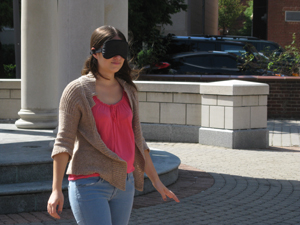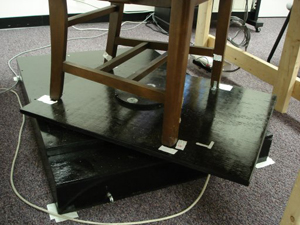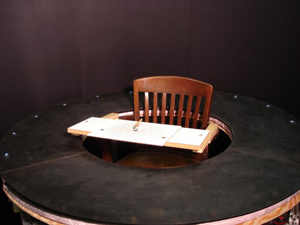Visual Space and Scene Perception

![]() The perception of the distance from oneself to an object in the world is generally thought to be supported by a plethora of information sources,
yet little is known about the factors that govern the accumulation of these cues over time.
How much viewing time is needed to perceive distance accurately?
Does it depend on the nature and range of cues that are available and informative in a given setting?
The perception of the distance from oneself to an object in the world is generally thought to be supported by a plethora of information sources,
yet little is known about the factors that govern the accumulation of these cues over time.
How much viewing time is needed to perceive distance accurately?
Does it depend on the nature and range of cues that are available and informative in a given setting?
These are fundamental questions given the fact that human vision is an inherently dynamic process.
While the visual world may seem continuous and everywhere-detailed,
our perception of a scene is actually built up from a series of brief glimpses, or fixations.
We typically shift our gaze from one location to the next at rate of around three times per second to collect the information about a given scene.
Our everyday life is dynamic, too.
Whether navigating busy sidewalks or driving automobiles, we may be called upon to judge distance in a blink of the eye.
In the Brain and Navigation Laboratory, we assess these abilities experimentally by controlling viewing durations of real world
scenes using a liquid crystal shutter window and by monitoring eye movements with an eyetracker.
We use a variety of methods for measuring people's perception of the distance and direction of nearby objects.
Of particular interest are "action-based" methods, such as walking or aiming a pointer at an object. These are useful ways of measuring perception because they do not rely
upon people's familiarity with numbers.
Navigation and Self-Motion Sensing
 Much of the work in the Brain and Cognition Laboratory investigates how people navigate in the very near environment.
Imagine turning out the light at night and then attempting to "navigate" in the room when it's dark,
or simply trying to walk to a known location while blindfolded.
People are generally able to do this pretty well.
This shows that people remember their environment and can keep track of their own body motions.
Much of the work in the Brain and Cognition Laboratory investigates how people navigate in the very near environment.
Imagine turning out the light at night and then attempting to "navigate" in the room when it's dark,
or simply trying to walk to a known location while blindfolded.
People are generally able to do this pretty well.
This shows that people remember their environment and can keep track of their own body motions.
In the Brain and Navigation Laboratory, we study the psychological and neural processes that allow us to perform tasks such as these.
Sometimes when people have injuries in and around the medial temporal lobe, the way they keep track of nearby objects and their own body motions changes.
These changes are seldom bothersome, but they are important for understanding how the brain monitors body and object motions.
In research funded by the National Institute for Neurological Disorders and Stroke,
we have tested the ability of people who have had brain surgery in these regions to keep track of simple body motions.
Our data suggest that the deficits are most pronounced when the task allows the participant to imagine the goal of locomotion.
Spatial Cognition and Spatial Memory

 When we move around in the world, we can often use our eyes to keep track of where things are.
But sometimes vision is not available.
How do we keep track of objects in these situations?
When we move around in the world, we can often use our eyes to keep track of where things are.
But sometimes vision is not available.
How do we keep track of objects in these situations?
In the Brain and Navigation Laboratory, we study this using a computer-controlled turntable, shown right.
Using this table, we can rotate people by various amounts to see how well they keep track of nearby objects.
